Nissan Pathfinder: Vq35dd - Unit Removal and Installation. Engine Assembly ++
Exploded View
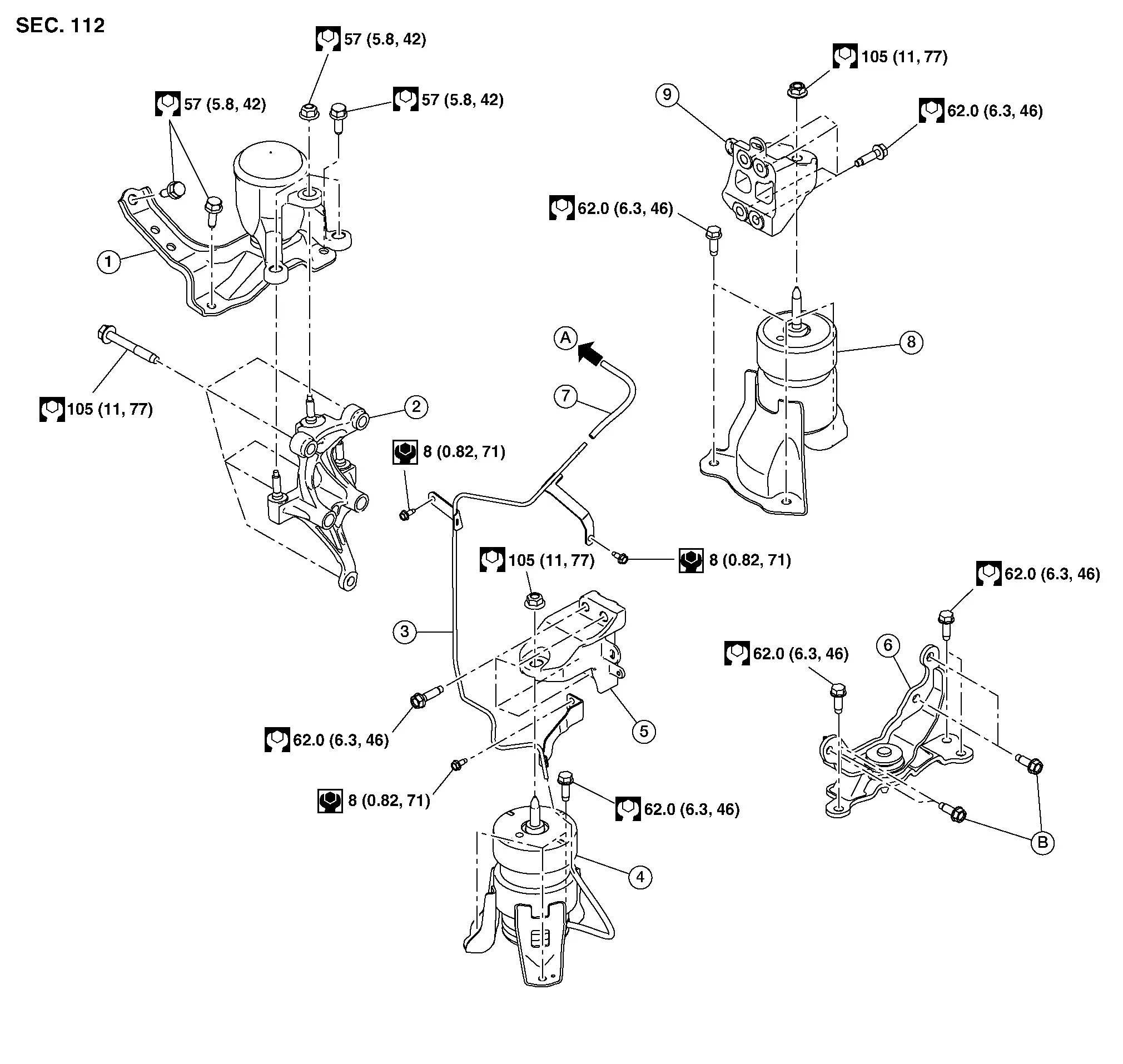
| 1. | Engine mounting insulator (RH) | 2. | Engine mounting bracket (RH) | 3. | Vacuum tube (front) |
| 4. | Engine mounting insulator (front) | 5. | Engine mounting bracket (front) | 6. | Engine mounting insulator (LH) |
| 7. | Vacuum hose | 8. | Engine mounting insulator (rear) | 9. | Engine mounting bracket (rear) |
| A. | To electronic controlled engine mount control solenoid valve. Refer to Component Parts Location. | B. | Refer to Removal and Installation. |
Removal and Installation
WARNING:
-
Situate the vehicle on a flat and solid surface.
-
Place chocks at front and back of rear wheels.
-
For engines not equipped with engine slingers, attach proper slingers and bolts described in PARTS CATALOG.
CAUTION:
-
Always work safely.
-
Do not start work until the engine and exhaust system are cooled completely.
-
Refer to the applicable sections for warnings, cautions, notes, and instructions if necessary procedures are not included in the engine section.
-
For supporting, lifting and jacking points, refer to Garage Jack and Safety Stand and 2–Pole Lift.
-
Always use the support point specified for lifting.
-
Support the Nissan Pathfinder vehicle at the rear axle jacking point with transmission jack or similar tool before removing the engine in preparation for the backward shift of the center of gravity.
 NOTE:
NOTE:
-
When removing components such as hoses, tubes/lines, etc., cap or plug openings to prevent fluid from spilling.
-
Remove the engine and transaxle with the front suspension member as a unit. Separate the engine from the transaxle and remove from the front suspension member.
REMOVAL
Release fuel pressure. Refer to Work Procedure.
Drain engine coolant. Refer to Draining.
CAUTION:
-
Perform this step when the engine is cold.
-
Do not allow the engine coolant to contact the drive belts.
Recycle the refrigerant. Refer to Recycle Refrigerant.
Remove the cowl top and cowl top extension. Refer to Removal and Installation.
Remove the core support cover. Refer to Exploded View.
Remove the front air duct. Refer to Exploded View.
Remove the battery and battery tray. Refer to Removal and Installation.
Disconnect the harness connectors from the ECM. Refer to Harness Connector (LEVER LOCKING TYPE).
Remove the ECM and ECM bracket. Refer to Exploded View.
Remove the front wheels and tires using power tool. Refer to Removal and Installation.
Remove the fender protector side cover (RH/LH). Refer to Exploded View.
Partially remove the front over fender (RH/LH). Refer to Exploded View.
Partially remove the front fender protector (RH/LH). Refer to Exploded View.
Disconnect the harness connector (A) from the electric intake valve timing control module (1).
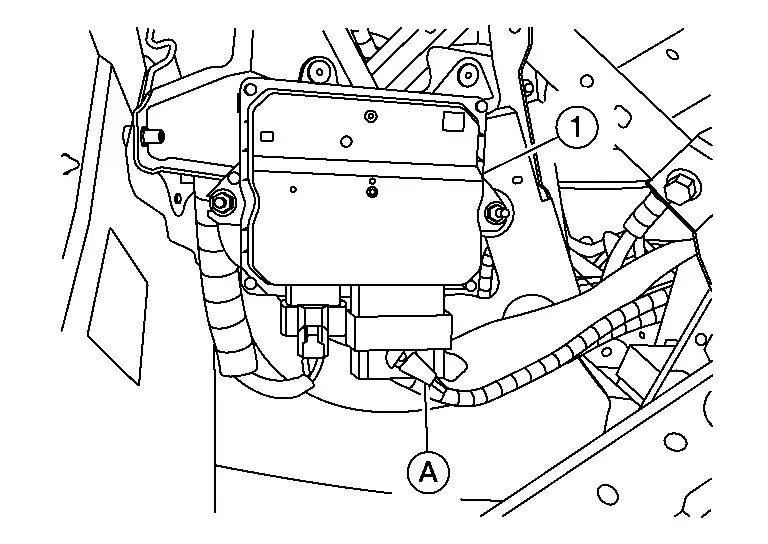
Release harness retainer and reposition engine harness into engine room.
Disconnect harness connector (A).
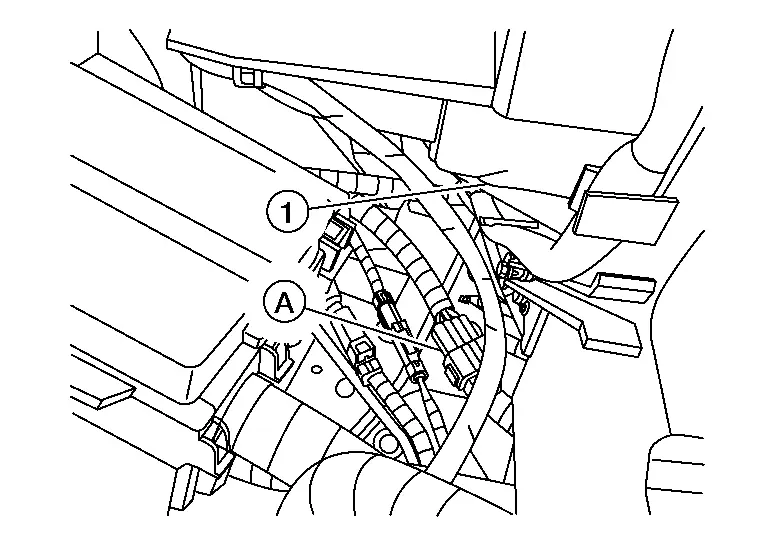
| (1) | : Front combination lamp (LH) |
Remove the fuse block cover.
Release fuse block cover A (A) pawls from the fuse block (1) and remove the fuse block cover A.
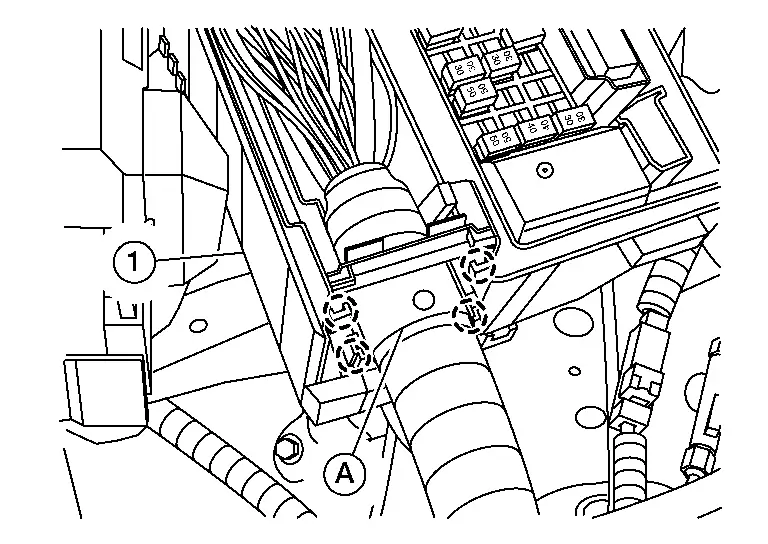
 |
: Pawl |
Reposition engine harness.
Release fuse block cover B (A) pawls from the fuse block (1) and remove the fuse block cover B.
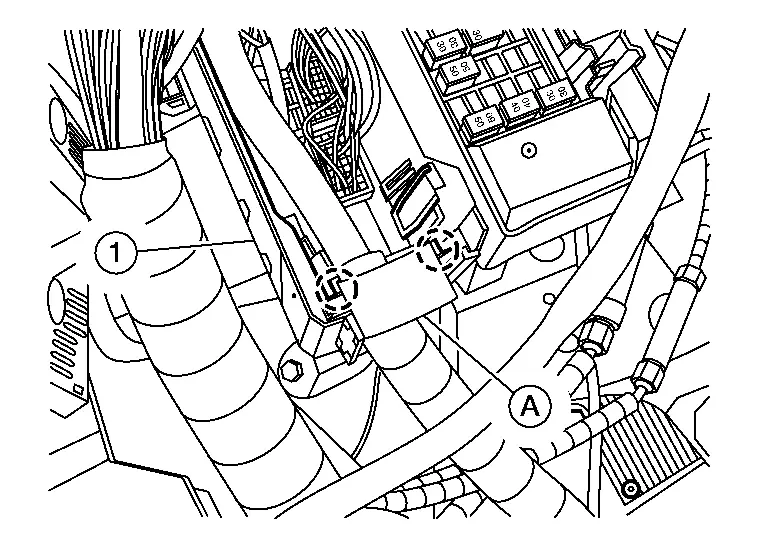
 |
: Pawl |
Disconnect the harness connectors (A) from the fuse block.
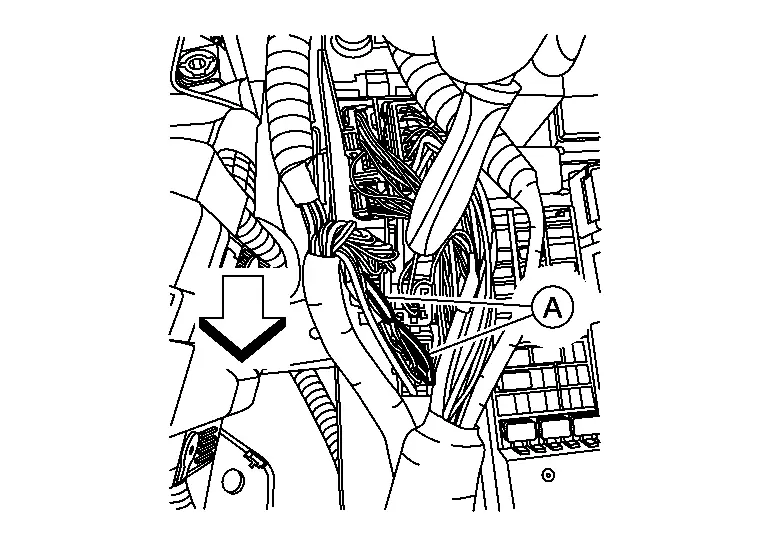
 |
: Front |
Release the pawls and separate the IPDM E/R (1) from the IPDM E/R case.
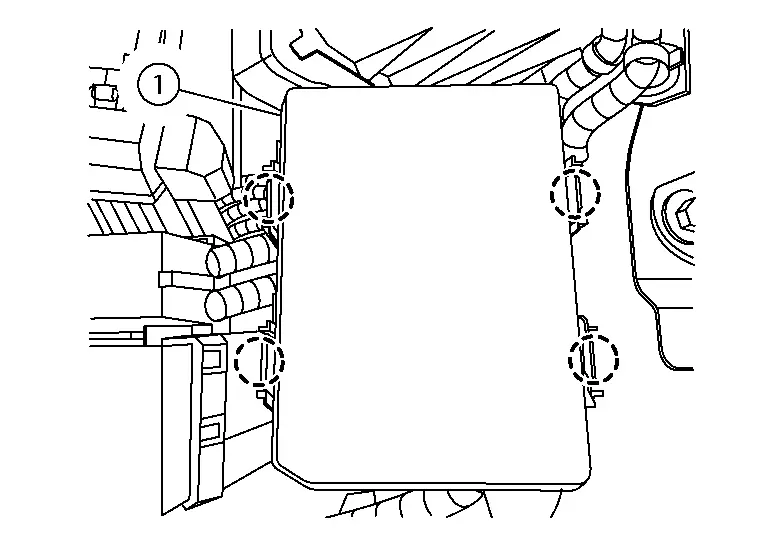
 |
: Pawl |
Release pawls and remove the IPDM E/R cover (A) from the IPDM E/R housing.
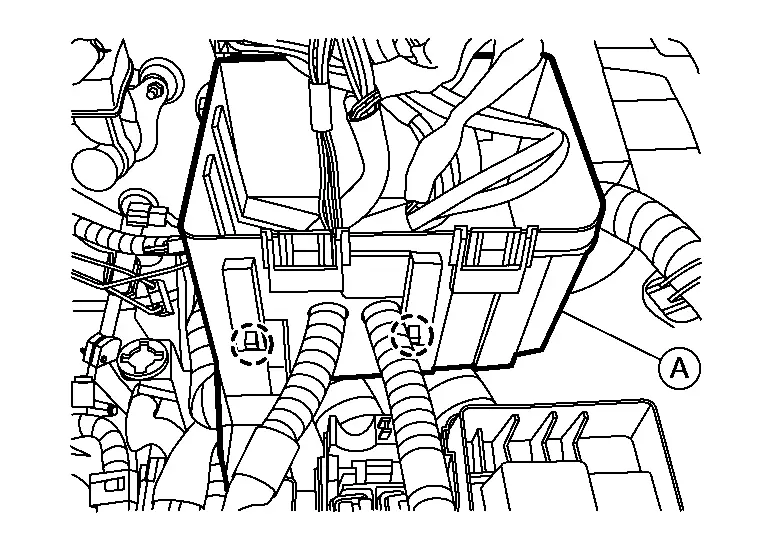
 |
: Pawl |
Disconnect the harness connector (A) from the IPDM E/R.
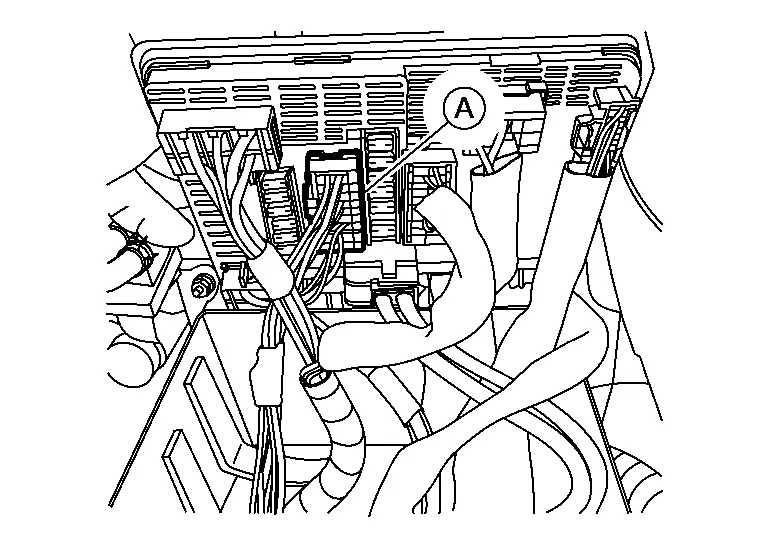
Remove bolt (A) and nut (B) and reposition engine harness.
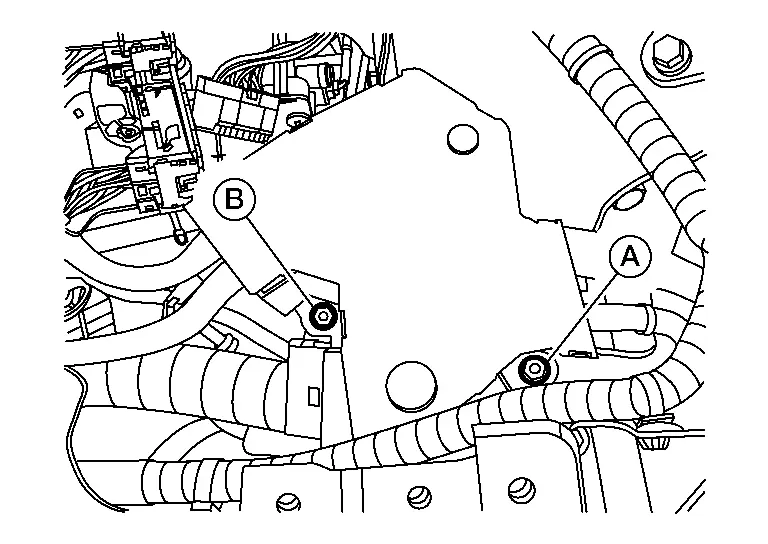
Remove the radiator hose (upper) from the water outlet pipe. Refer to Exploded View.
Remove the fuel line protector and disconnect the fuel feed hose from high pressure fuel pump using suitable tool. Refer to Exploded View.
Remove the EVAP hose from the vacuum delay valve. Refer to Exploded View.
Remove the vacuum hose from the intake manifold. Refer to Exploded View.
Remove the high-pressure flexible hose from the high-pressure pipe. Refer to Exploded View.
Remove the low-pressure flexible hose from the low-pressure pipe. Refer to Exploded View.
Remove the battery positive terminal cover from the fusible link box (battery). Refer to Exploded View.
Remove the positive cable nut and remove the positive cable from the fusible link box (battery). Refer to Exploded View.
Remove the heater hoses from the water outlet and heater pipe. Refer to Exploded View.
Disconnect the harness connectors (C) for the steering gear and linkage assembly harness (A) and remove the harness from brackets (B).
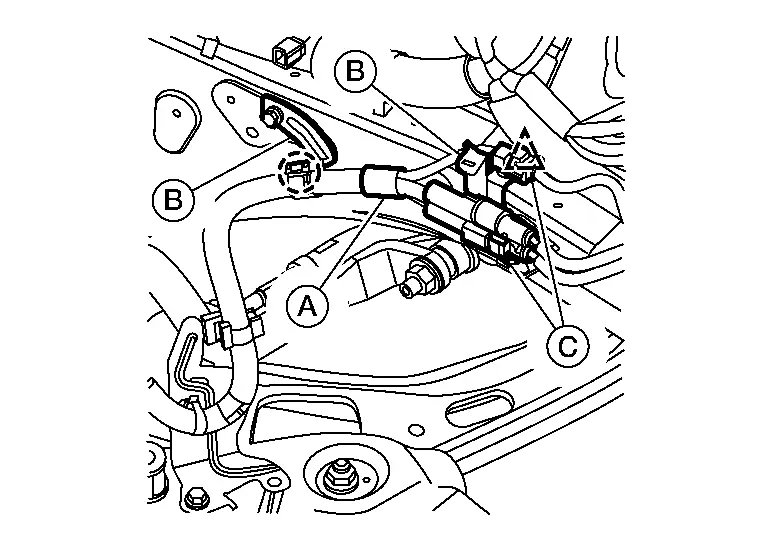
 |
: Clip |
 |
: Pawl |
Remove bolt (A) and remove the ground cable from the front cover and release harness retainer (B) from bracket.

| (1) | : Valve timing control cover (bank 2) |
Remove the engine mounting insulator (RH).
Remove the ground cable from the transaxle assembly.
Remove the A/T fluid cooler hoses from the A/T fluid warmer using the following procedure:Remove the A/T fluid cooler hose cap (1) from the A/T fluid cooler hose (2).
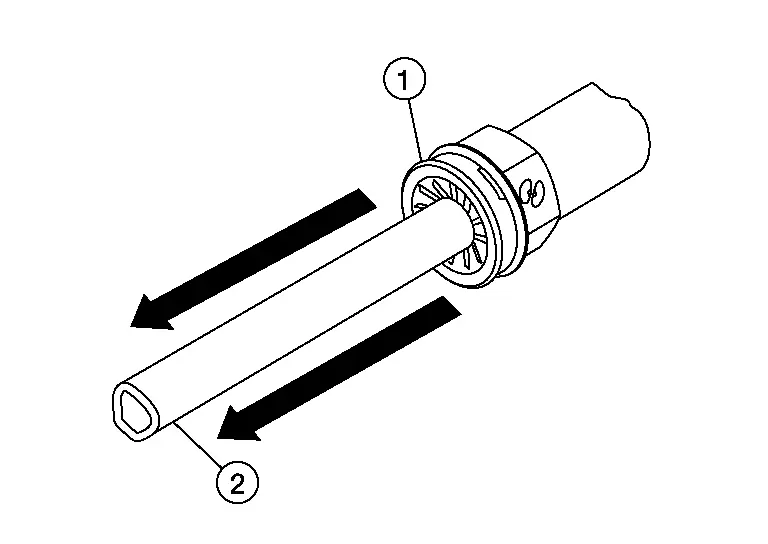
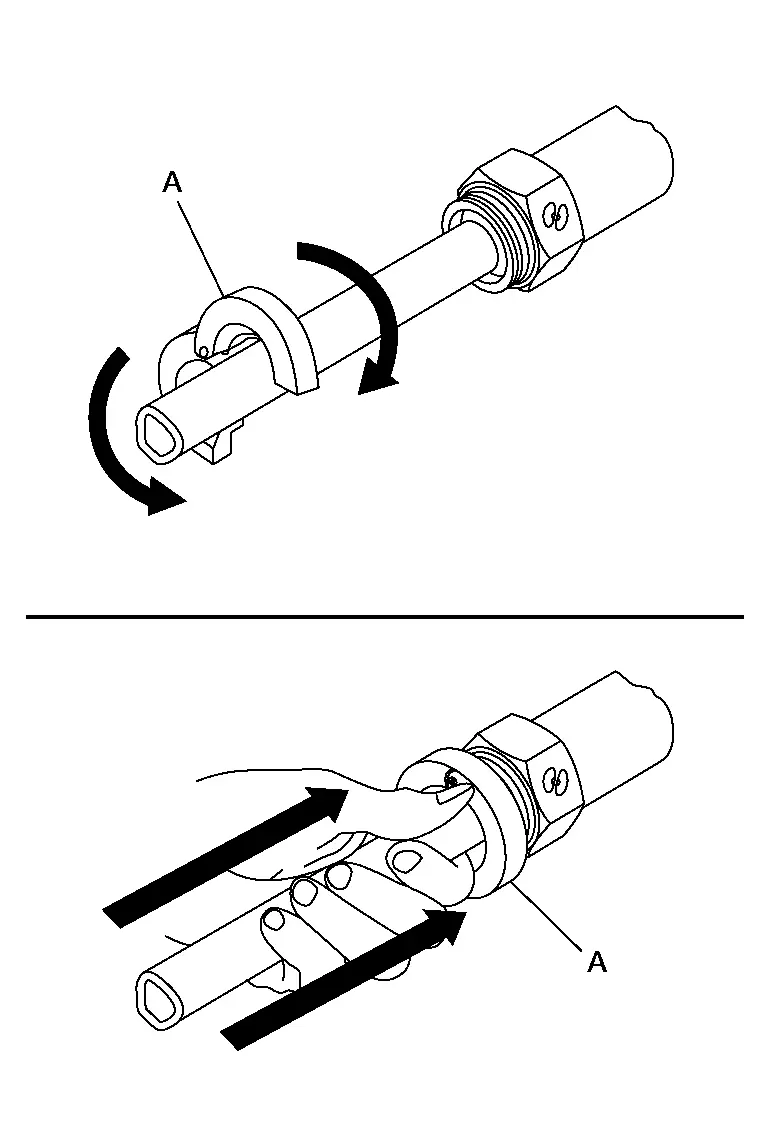
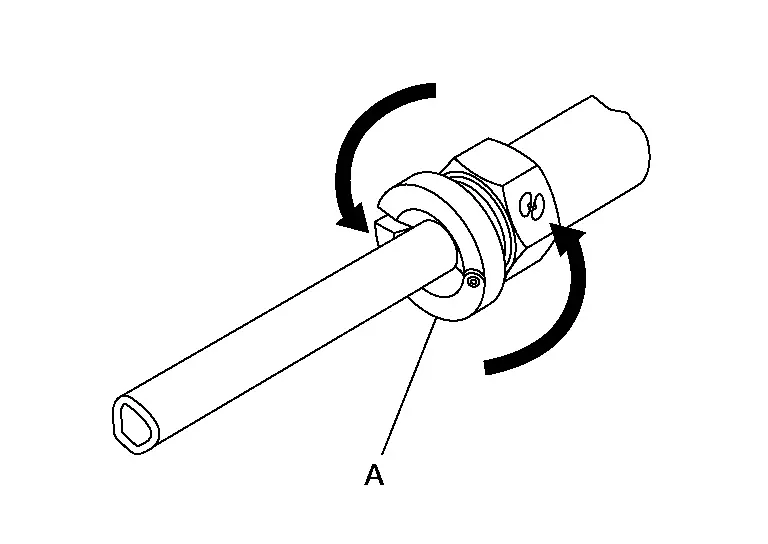
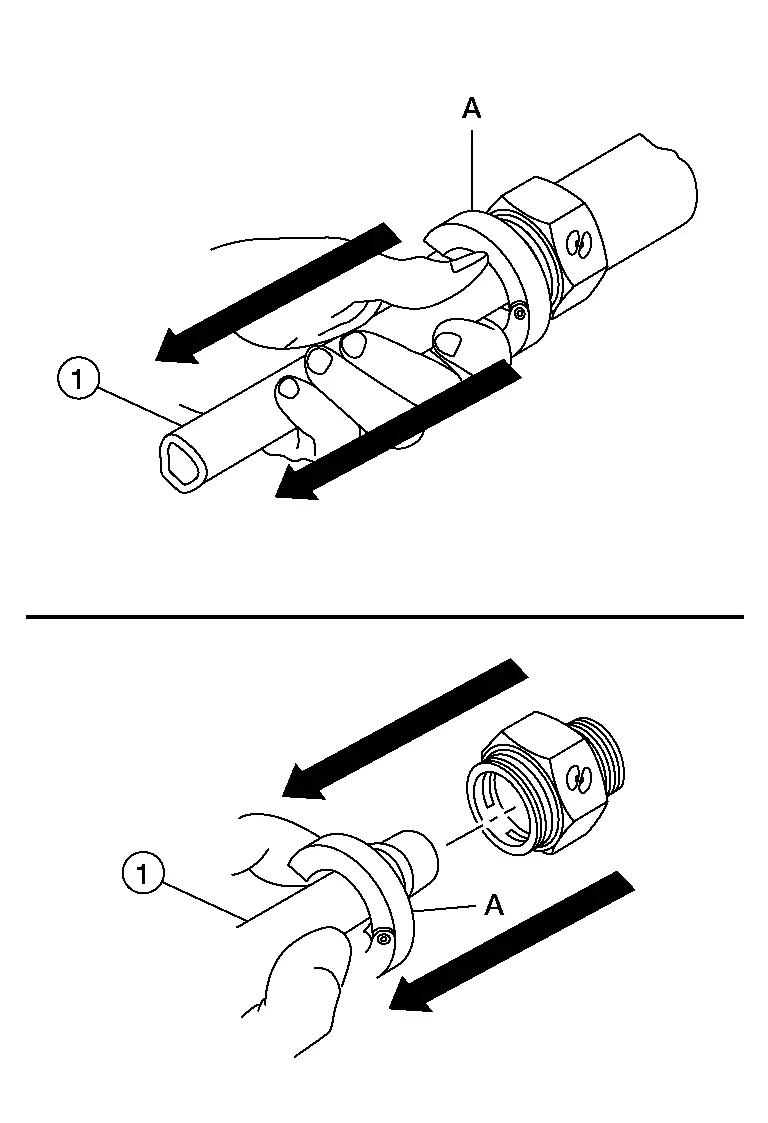
| (A) | : Suitable tool |
Remove the front exhaust tube. Refer to Exploded View.
Remove the propeller shaft assembly. Refer to Removal and Installation (4WD models only).
Remove the rear plate cover. Refer to Exploded View.
Rotate engine and remove the torque converter nuts. Refer to Exploded View.
Remove steering pinch bolt and separate the lower joint from steering gear and linkage. Refer to Exploded View.
CAUTION:
With the steering linkage disconnected, the spiral cable may snap by turning the steering wheel beyond the limited number of turns. Secure the steering wheel during removal of the steering gear.
Remove the front disc brake rotor (RH/LH). Refer to Removal and Installation.
Remove wheel sensor bolt and position wheel sensor aside. Refer to Exploded View.
Using suitable tool (A) and Tool (B) release staked area (C) of wheel hub lock nut (D).
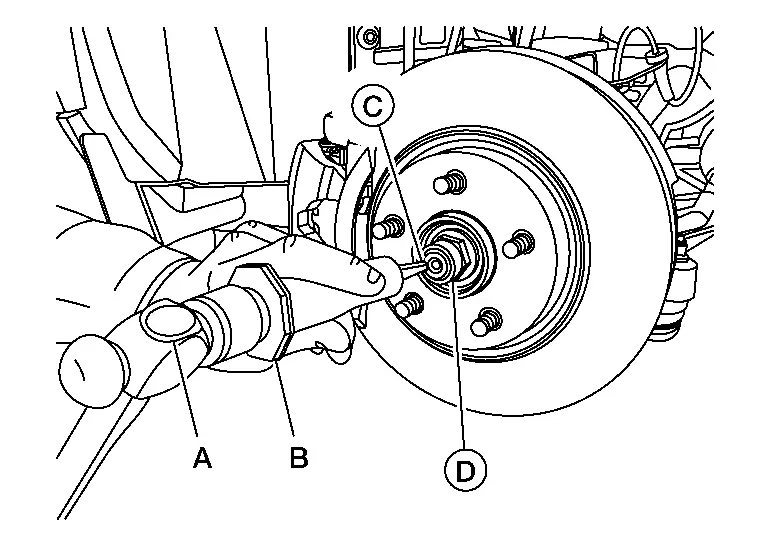
| Tool (B) | : — (NI-52982) |
Visually verify that staked area (A) of wheel hub lock nut (B) is completely released from front drive shaft (1) or damage to drive shaft can occur.
WARNING:
To avoid risk of death or severe personal injury:
-
Be sure that staked area of wheel hub lock nut is fully released or damage to drive shaft can occur.
-
Do not damage front drive shaft threads.
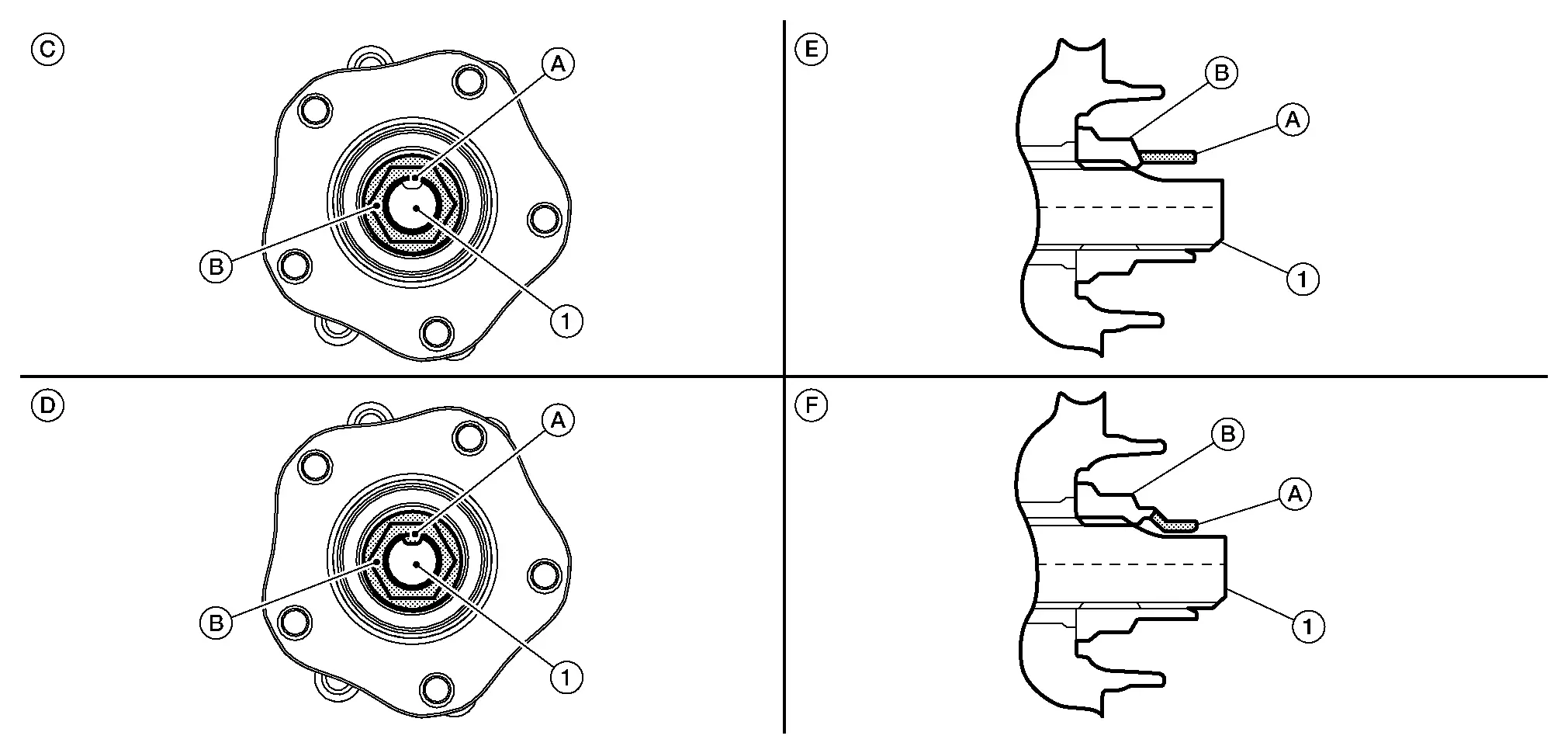
| (C) | : Fully released |
| (D) | : Not fully released |
| (E) | : Fully released (sectional view) |
| (F) | : Not fully released (sectional view) |
Loosen wheel hub lock nut but do not remove from drive shaft.
WARNING:
To avoid risk of death or severe personal injury:
-
Do not use power tool.
-
Do not reuse wheel hub lock nut.
-
When loosening wheel hub lock nut, if it does not turn smoothly, verify staked area is completely released.
-
Do not damage front drive shaft threads.
Using a piece of wood and a suitable tool, tap on the wheel hub lock nut to disengage drive shaft from wheel hub.
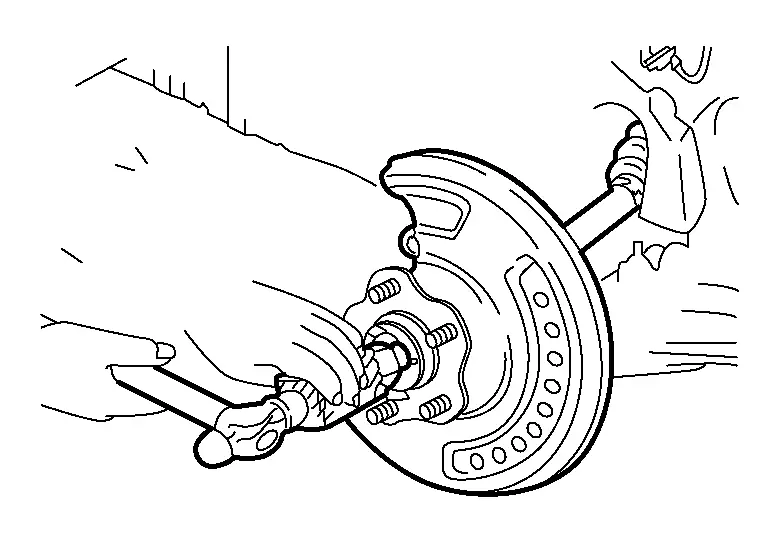
WARNING:
To avoid risk of death or severe personal injury:
-
Do not place drive shaft at an extreme angle. Be careful not to over extend slide joint.
-
Do not allow drive shaft to hang without support.
 NOTE:
NOTE:
Use a suitable puller if drive shaft cannot be separated from wheel hub and bearing.
Remove wheel hub lock nut.
CAUTION:
Do not reuse wheel hub lock nut.
Remove nuts and bolts and separate the steering knuckle from the strut. Refer to Exploded View.
CAUTION:
Do not reuse nuts.
Remove nuts and separate the stabilizer connecting rod from the strut. Refer to Exploded View.
Remove the bearing retainer bolts and remove the bearing retainer. Refer to Exploded View.
Insert suitable tool (A) between the drive shaft and the transaxle. Remove the drive shaft from the transaxle (LH/RH).
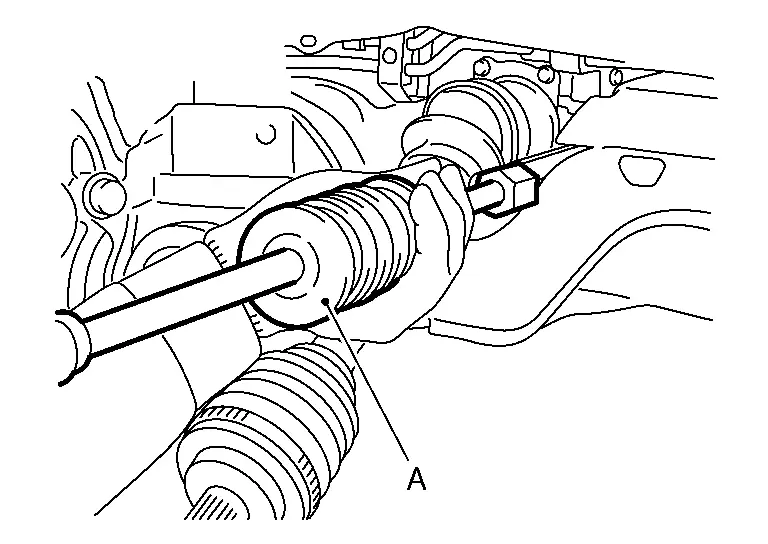
CAUTION:
-
Confirm that the circular clip is attached to the drive shaft
-
Do not place the drive shaft joint at an extreme angle when removing the drive shaft. Also be careful not to overextend the slide joint.
For 2WD models, remove the differential side oil seal (RH/LH). Refer to Exploded View.
CAUTION:
Do not reuse differential side oil seal.
For 4WD models, remove the differential side oil seal (LH). Refer to Exploded View.
CAUTION:
Do not reuse differential side oil seal.
Remove the front under cover (RH/LH). Refer to Removal and Installation.
Remove the radiator hose (lower) from the thermostat assembly (water inlet). Refer to Exploded View.
Drain the transfer assembly oil. Refer to Draining (4WD models only).
Using a suitable tool, remove suspension member bolts and remove suspension member, engine and transmission assembly. Refer to Exploded View.
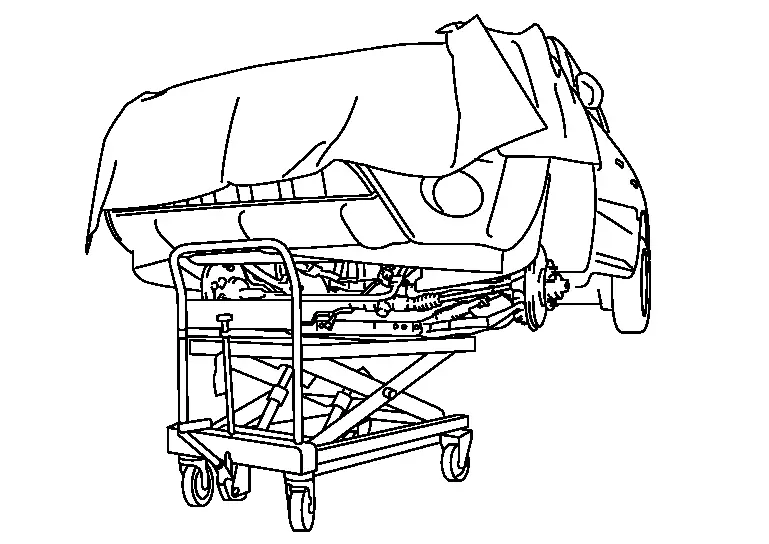
CAUTION:
-
Put a piece of wood or something similar as the supporting surface to secure a completely stable condition.
-
Confirm there is no interference with the Nissan Pathfinder vehicle.
-
Repeatedly check to ensure all harnesses are disconnected before and during engine removal.
-
Check all connection points have been disconnected.
-
Keep in mind the center of Nissan Pathfinder vehicle gravity changes. If necessary, use jack(s) to support the vehicle at rear jacking point(s) to prevent it from falling off the lift.
Remove vacuum hoses from vacuum tube (front). Refer to Exploded View.
Remove bolts and remove the vacuum tube (front). Refer to Exploded View.
Remove bolts (A) and reposition bracket and engine harness.
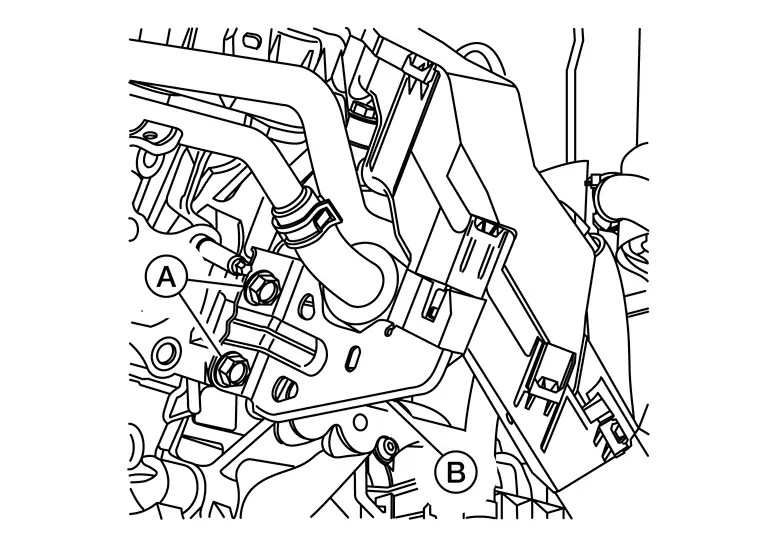
 NOTE:
NOTE:
Exhaust manifold (bank 2) is removed for clarity.
Install engine slingers into the front of cylinder head (bank 1) and rear of cylinder head (bank 2).
-
Cylinder head (bank 1)
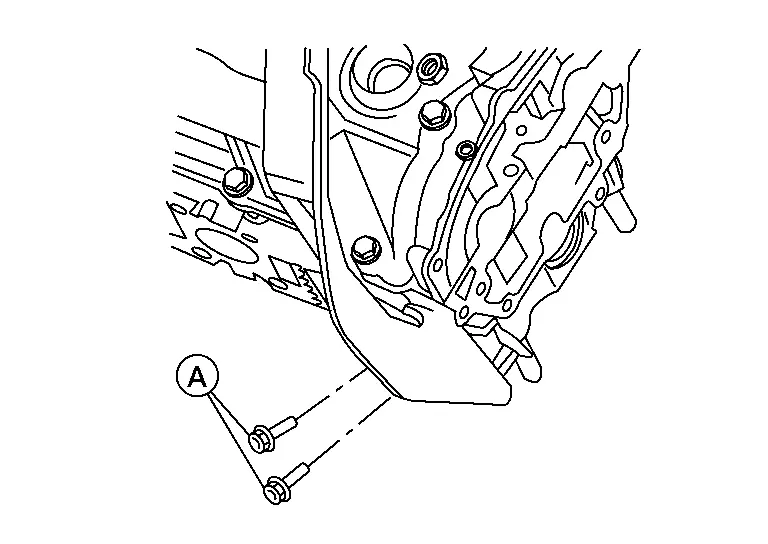
Bolts (A) : 28 N·m (2.9 kg-m, 21 ft-lb) -
Cylinder head (bank 2)
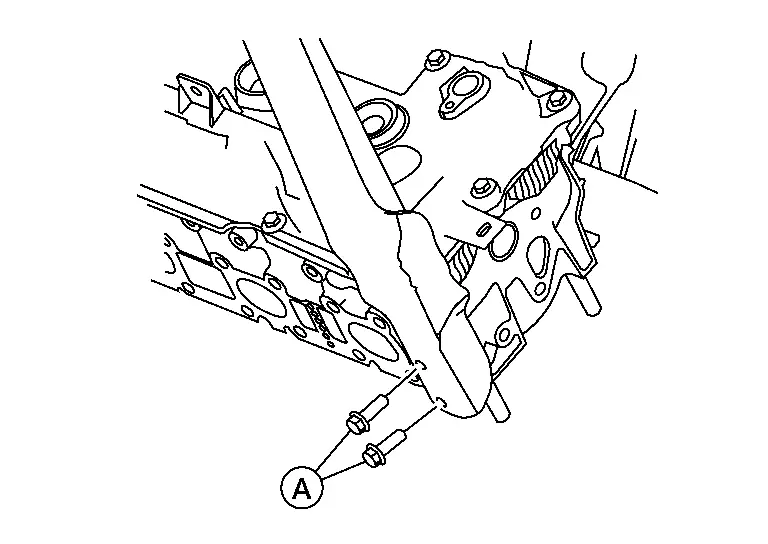
Bolts (A) : 28 N·m (2.9 kg-m, 21 ft-lb)
Remove the nut securing the engine mounting bracket (front) to the engine mounting insulator (front). Refer to Exploded View.
Remove bolts securing engine mounting insulator (LH) to front suspension member. Refer to Exploded View.
Remove the nut securing the engine mounting bracket (rear) to the engine mounting insulator (rear). Refer to Exploded View.
Remove the engine and transaxle assembly from the front suspension member.
Remove the lower four bolts securing the transaxle assembly to the engine. Refer to Exploded View.
For 4WD models only, remove the transfer assembly using the following procedure:
-
Disconnect the harness connector from the air fuel ratio (A/F) sensor (bank 1) and remove harness from retainer.
-
Remove exhaust manifold (bank 1) cover. Refer to Exploded View.
-
Disconnect the harness connector from the heated oxygen sensor 2 (bank 1) and remove harness from retainers.
-
Remove bolt securing three way catalyst support (bank 1) to the support bearing bracket. Refer to Exploded View.
-
Remove the exhaust manifold and three way catalyst (bank 1) nuts in reverse of the sequence shown and remove the exhaust manifold and three way catalyst (bank 1).
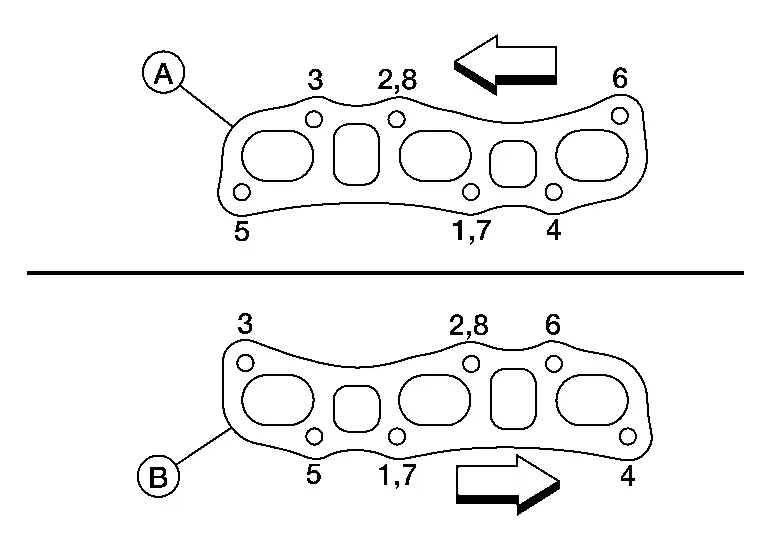
CAUTION:
Do not reuse gasket.
 NOTE:
NOTE:
Number 7 and 8 are not applicable to removal.
(A) : Bank 2 (B) : Bank 1 
: Engine front -
Remove the gusset. Refer to Exploded View.
-
Disconnect the harness connector from the transfer case temperature sensor.
-
Remove bolts and remove the transfer assembly. Refer to Exploded View.
Remove the “B” terminal nut and "S" terminal nut and position harnesses aside. Refer to Exploded View.
Remove bolts and remove the starter motor. Refer to Exploded View.
Remove harness retainers from transaxle assembly.
Rotate transaxle harness connector counterclockwise and disconnect transaxle harness connector.
Disconnect harness connectors from the crankshaft position sensor and heated oxygen sensor 2 (bank 2).
Remove the crankshaft position sensor. Refer to Exploded View.
CAUTION:
-
Handle carefully to avoid dropping and shocks.
-
Do not disassemble.
-
Do not allow metal powder to adhere to magnetic part at sensor tip.
-
Do not place sensors in a location where they are exposed to magnetism.
Disconnect the harness connectors from the TCM and idle stop switch (if equipped) and reposition the engine harness.
Remove the A/T water hose A from the water outlet and A/T water hose B from the water pipe. Refer to Exploded View.
Remove the remaining bolts and separate the transaxle assembly to the engine assembly. Refer to Exploded View.
INSTALLATION
Installation is in the reverse order of removal.
CAUTION:
-
Do not allow engine oil to get on engine mounting insulator. Be careful not to damage engine mounting insulator.
-
Check all mounting insulators are seated properly, then tighten nuts and bolts.
-
If engine mounting insulator (LH) is removed from transaxle assembly, install and tighten bolts to the specified torque.
Full threaded bolt : 70 N·m (7.1 kg-m, 52 ft-lb) Partially threaded bolt : 62.0 N·m (6.3 kg-m, 46 ft-lb) -
After installation of engine and transaxle assembly, refer to Inspection.
-
Refill the engine coolant. Refer to Refilling.
-
Refill the transfer assembly oil. Refer to Refilling (4WD models only).
-
Recharge refrigerant. Refer to Charge Refrigerant.
CAUTION:
After charging refrigerant, check for leaks. Refer to Leak Test.
-
When installing the drive shaft (RH/LH), note the following:
-
Install a new differential side oil seal. Refer to Removal and Installation (LH) or Removal and Installation (RH).
-
In order to prevent damage to differential side oil seal, place Tool (A) onto oil seal before inserting drive shaft as shown. Slide drive shaft into slide joint and tap with a suitable tool to install securely.
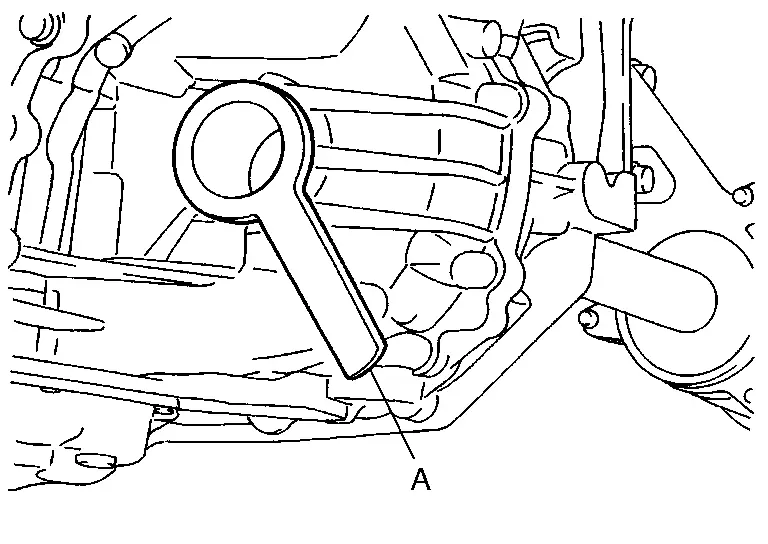
Tool number : KV38107900 (NI-52469-1) -
Install new circlip on drive shaft in the circular clip groove on transaxle side. Refer to Disassembly and Assembly (LH).
WARNING:
Ensure that circular clip is properly engaged, otherwise the joint subassembly could pull away from transaxle during Nissan Pathfinder vehicle operation resulting in loss of drive force and possible drive shaft damage, which may cause a crash and serious injury or damage the drive shaft.
 NOTE:
NOTE:
To ensure the circular clip is properly engaged, grasp the housing (1) and pull back and forth in axial direction while listening for clicking sounds.
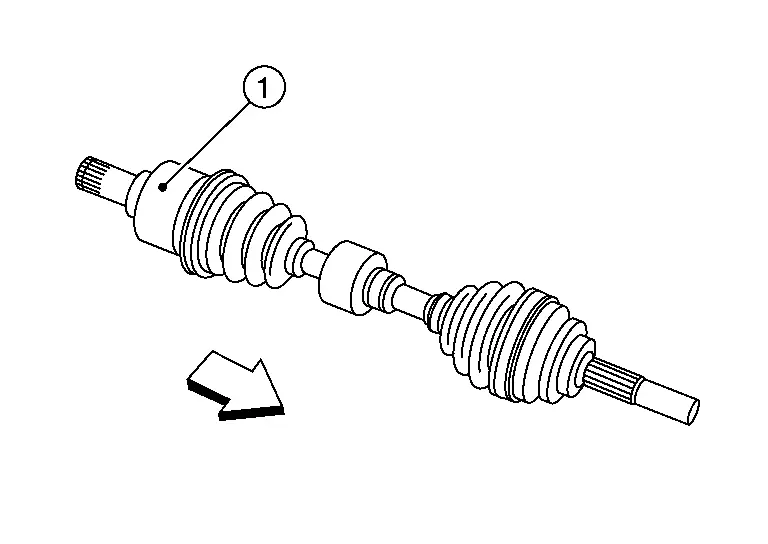
Pull the joint sub-assembly in the axial direction away from transaxle assembly (
 ). Confirm that the joint sub assembly cannot be pulled out.
). Confirm that the joint sub assembly cannot be pulled out. -
Clean the matching surface of drive shaft and wheel hub assembly. And then apply paste to surface (A) of joint sub-assembly of drive shaft.
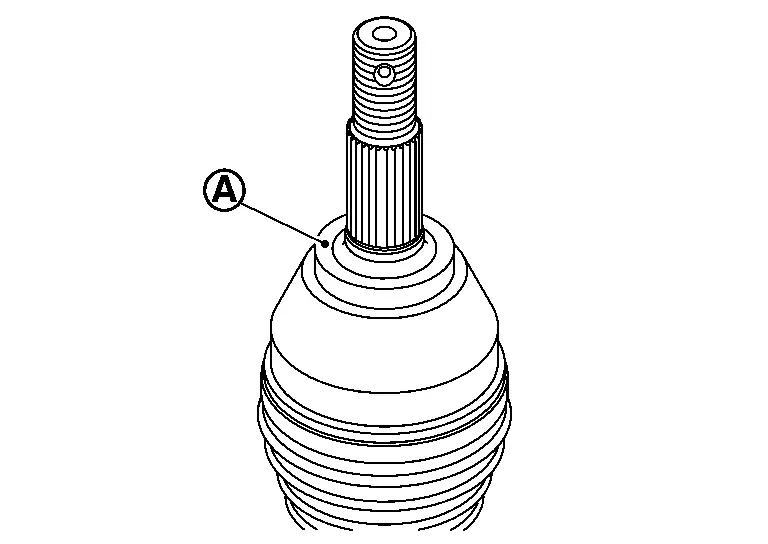
 NOTE:
NOTE:
To avoid damage to the Nissan Pathfinder vehicle:
-
Apply paste to cover entire flat surface of joint sub-assembly of drive shaft.
Paste amount : 1.0 - 3.0 g (0.04 - 0.10 oz)
-
-
Hold wheel hub and bearing using a suitable tool. Tighten wheel hub lock nut.
Wheel hub lock nut : Refer to Exploded View (LH) or Exploded View (RH). WARNING:
To avoid risk of death or severe personal injury:
-
Since drive shaft is assembled by press-fitting, use a torque wrench to tighten wheel hub lock nut. Do not use a power tool.
-
Too much torque causes axle noise. Too little torque causes wheel bearing looseness.
-
Do not reuse the wheel hub lock nut.
-
-
Using suitable tool (A) and cold chisel (B) stake the wheel hub lock nut (C) as shown.
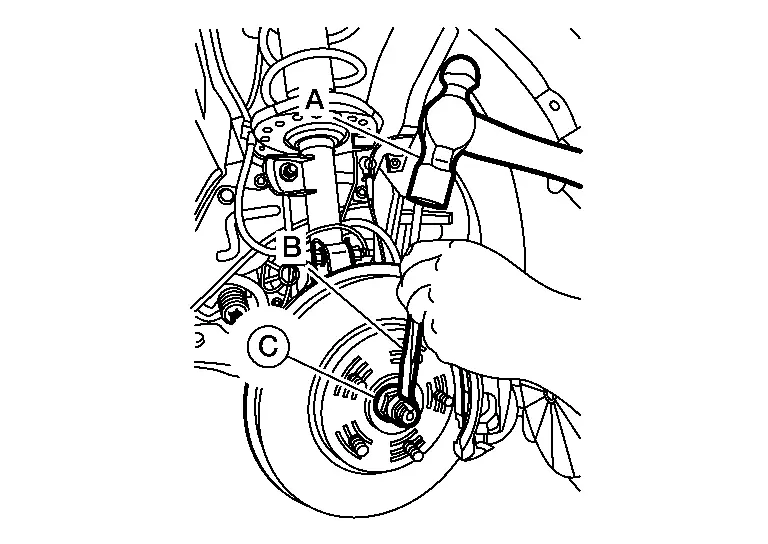
WARNING:
To avoid the risk of death or severe personal injury:
-
Use the following range when staking the wheel hub lock nut.
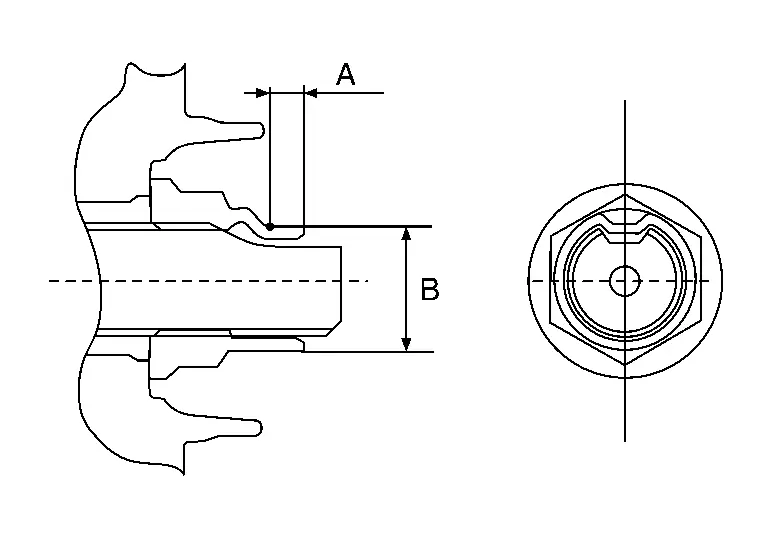
(A) : 6.2 mm (0.244 in) (B) : 26.4 - 27.8 mm (1.039 - 1.094 in) -
-
Tighten the bearing retainer bolts to the specified torque in the sequence shown.
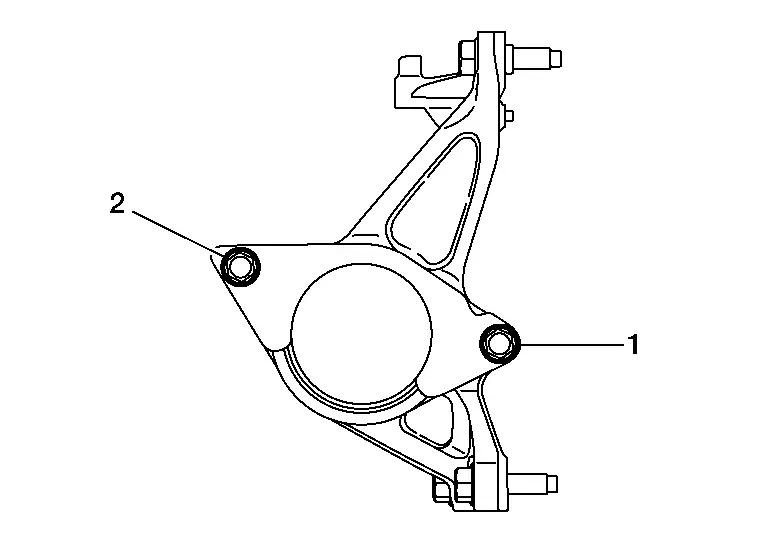
Bearing retainer bolts : Refer to Exploded View (RH).
-
-
Install the exhaust manifold and three way catalyst (bank 1) assembly using the following procedure:
-
Install the exhaust manifold gasket in the direction shown.
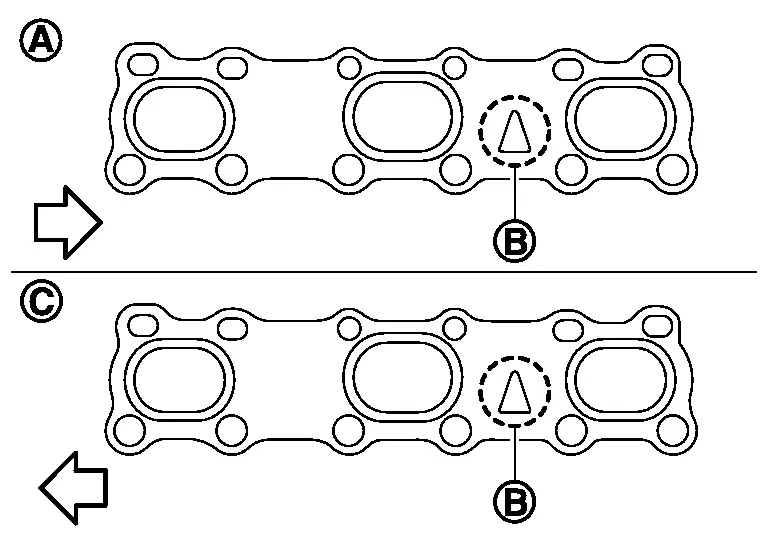
CAUTION:
Do not reuse gasket.
(A) : Bank 1 (B) : Triangle press (C) : Bank 2 
: Engine front -
Install the exhaust manifold (bank 1) nuts and tighten to the specified torque in the sequence shown.
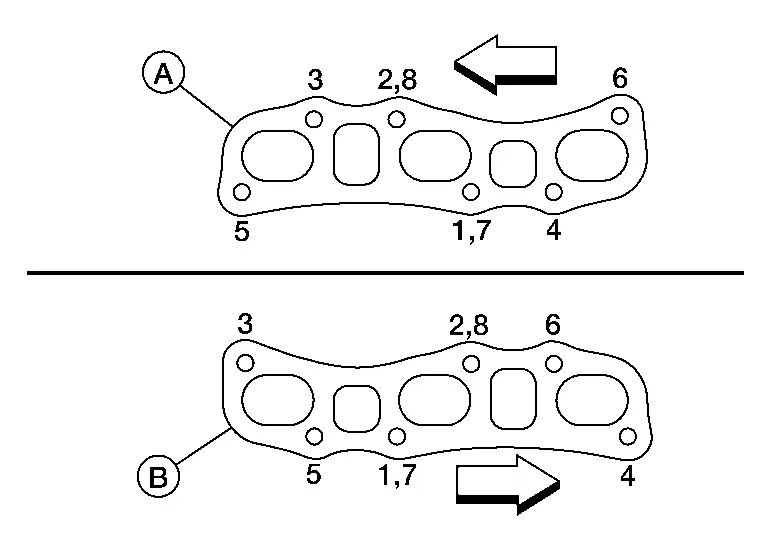
 NOTE:
NOTE:
Number 7 and 8 are tightened a second time.
Exhaust manifold and three way catalyst (bank 1) nuts : 30.9 N·m (3.2 kg-m, 23 ft-lb) 
: Engine front (A) : Bank 2 (B) : Bank 1
-
Inspection
INSPECTION AFTER INSTALLATION
Check wheel alignment. Refer to Inspection.
Perform "ADJUSTMENT OF STEERING ANGLE SENSOR NEUTRAL POSITION". Refer to Description.
When replacing or removing engine assembly, Perform "SERVICE AFTER REPLACING OR REMOVING ENGINE PARTS." Refer to Special Repair Requirement List.
Check A/T fluid level. Refer to Inspection.
INSPECTION FOR LEAKAGE
The following are procedures for checking fluid leakage, lubricant leakage, and exhaust gas leakage.
-
Before starting engine, check oil/fluid levels including engine coolant and engine oil. If less than required quantity, fill to the specified level. Refer to Fluid and Lubricants (FOR USA AND CANADA) or Fluids and Lubricants (FOR MEXICO).
-
Use procedure below to check for fuel leakage:
-
Place ignition switch in the “ON” position (with engine stopped). With fuel pressure applied to fuel piping, check for fuel leakage at connection points.
-
Start engine. With engine speed increased, check again for fuel leakage at connection points.
-
-
Run engine to check for unusual noise and vibration.
 NOTE:
NOTE:
If hydraulic pressure inside timing chain tensioner drops after removal/installation, slack in guide may generate a pounding noise during and just after the engine start. However, this does not indicate an unusualness. Noise will stop after hydraulic pressure rises.
-
Warm up engine thoroughly to check that there is no leakage of fuel, or any oil/fluids including engine oil and engine coolant.
-
Bleed air from lines and hoses of applicable lines, such as in cooling system.
-
After cooling down engine, again check oil/fluid levels including engine oil and engine coolant. Refill to the specified level, if necessary.
Summary of the inspection items: Items Before starting engine Engine running After engine stopped Engine coolant Level Leakage Level Engine oil Level Leakage Level Transmission / transaxle fluid AT & CVT Models Leakage Level / Leakage Leakage MT Models Level / Leakage Leakage Level / Leakage Other oils and fluids* Level Leakage Level Fuel Leakage Leakage Leakage Exhaust gases — Leakage — *: Power steering fluid, brake fluid, etc.
Setting
 NOTE:
NOTE:
Explained here is how to disassemble with engine stand supporting transaxle surface. Some steps may be different if using a different type of engine stand.
Remove the drive plate. Refer to Removal and Installation.
Cut away liquid gasket and remove rear oil seal retainer using Tool. Refer to Precaution for Liquid Gasket.
| Tool number | : KV10111100 (NI-37228) |
CAUTION:
-
Do not damage mount surface.
-
If rear oil seal retainer is removed, replace it with a new one.
 NOTE:
NOTE:
Rear oil seal and retainer form a single part and are replaced as an assembly.
Lift the engine with a suitable hoist to install onto widely used engine stand.
CAUTION:
-
Use the engine stand that has a load capacity [approximately 146 kg (322 lb) or more] large enough for supporting the engine weight.
-
Before removing the hanging chains, check the engine stand is stable and there is no risk of overturning.
 NOTE:
NOTE:
Shown is an example of widely used engine stand (A) that can support mating surface of transaxle with the torsion damper removed.
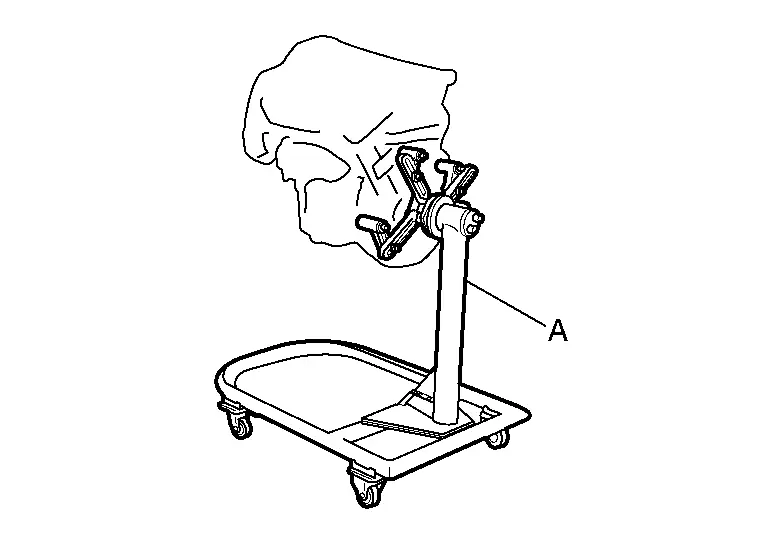
Drain the engine oil. Refer to Draining.

Nissan Pathfinder (R53) 2022-2025 Service Manual
Contact Us
Nissan Pathfinder Info Center
Email: info@nipathfinder.com
Phone: +1 (800) 123-4567
Address: 123 Pathfinder Blvd, Nashville, TN 37214, USA
Working Hours: Mon–Fri, 9:00 AM – 5:00 PM (EST)
